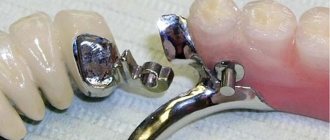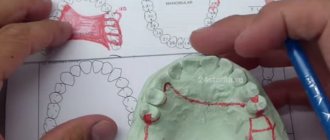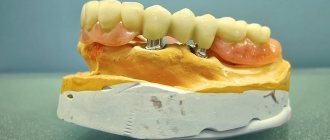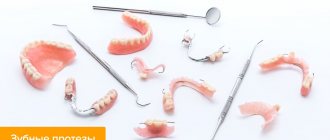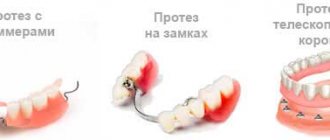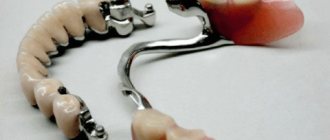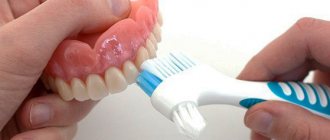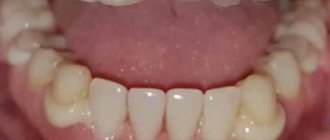Dental problems have plagued humanity since the beginning of time. In medieval Japan, for example, people were so desperate to give their smile an ideal look that the problem was solved radically: all Japanese, both men and women, painted their teeth with black varnish, which completely hid all imperfections, including the absence of some teeth.
A gap-toothed smile still causes serious psychological problems for its owner, but we live in a different culture, and the methods of the medieval Japanese do not suit us. Modern people cope with missing teeth using different types of dentures. Among them, acetal clasp dentures occupy far from the last place - they effectively cope with the restoration of chewing function and the natural aesthetic appearance of the dentition.
What kind of prosthesis is this and what features does it have?
An acetal denture is a partial removable [1] orthopedic structure made of synthetic resin (polyacetal). It is light and durable, allowing you to make comfortable dentures for installation on the upper or lower jaw with partial absence of teeth. Acetal is most often used to make crowns, hooks or clasps (fixing components), frames or arches, and less commonly - core inlays, gum formers for installation on implants. Removable acetal ones are attached to the supporting teeth using clasps.
PROSTHETICS WITH 6 OSSTEM IMPLANTS FROM RUB 200,000.
Complex implantation Osstem (South Korea) with delayed loading after 4-6 months.
Call now or request a call
Acetal removable dentures are distinguished from others by the shade of the clasps, frame (arch), and palatal bridge on the upper jaw. If, for example, clasp ones are gray metallic, and acrylic and nylon ones are translucent pink, then acetal ones are white or milky matte, not transparent.
Peculiarities
The method of restoring teeth using acetal dentures is quite new, but nevertheless already popular.
Acetal or polyacetal is used to make these removable dentures. The material is a synthetic resin. An acetal is composed of oxygen, carbon and hydrogen. The substance has a unique molecular structure, which consists of thread-like elongated particles tightly connected to each other. No additives are used in the manufacture of the prosthesis, therefore acetal structures are hypoallergenic and safe.
Among other things, acetal can be combined with any substances. The strength of the material is similar to metal, and its flexibility is tens of times greater than that of metal structures.
Prostheses can be fixed using either acetal hooks or metal elements, which are very reliable and at the same time invisible to others.
Acetal structures are used both to replace single teeth and to restore a large number of dental units.
What material is used
Acetal (more precisely, polyacetal, polyformaldehyde, polyoxymethylene) is an organic thermoplastic compound discovered about 100 years ago. The material is initially crystalline and has a white, or rather milky color, and is opaque. Some manufacturers color the material according to the Vita scale in 15-17 shades for artificial teeth and pink shades for gums. The material is supplied marked: “Acetal plastic” or “monomer-free acetate plastic”. Quality brands – Evihard, Nuxen, Pressing Dental Srl
Acetal is hydrophobic, i.e. does not absorb oral fluid, saliva, or water at all. It is resistant to alkalis, but can be destroyed in an acidic environment, so you should be careful when consuming acidic foods and drinks.
In terms of strength, polyacetal can be compared with a cobalt-chromium alloy - they have approximately equal characteristics in terms of distribution of chewing load, resistance to abrasion and deformation during long-term use. The material melts at a temperature of 180 degrees Celsius, i.e. You can safely consume hot food and drinks. The absence of toxic acrylic monomer in the composition greatly reduces the risk of an allergic reaction.
Indications and contraindications
Indications for the installation of acetal prostheses are the following cases:
- the need to restore 1-2 or more teeth: for good fixation and load distribution, at least 6-7 teeth must be preserved in the row,
- the remaining teeth exhibit mobility of the 1st degree,
- increased abrasion of enamel,
- included and end defects: in the first case, teeth are preserved along the edges of the “gap” (where there is no tooth), in the second case there are no teeth at the edge of the row,
- inflammation of the gums: gingivitis, periodontitis,
- inconvenience in wearing other orthopedic structures: for example, if acrylic ones cause discomfort due to their massiveness, and clasp ones provoke galvanosis (the appearance of an electrical impulse between dissimilar metals),
- allergies to other synthetic materials and metals,
- the need for temporary prosthetics before implantation, if it is not yet possible to install implants.
Contraindications are such clinical cases as:
- complete or almost complete edentia (absence of teeth),
- pronounced mobility of the remaining supporting teeth,
- severe atrophy of the alveolar ridge (loss of bone and gums),
- allergic reaction to the material or increased sensitivity of the gums,
- small sizes of supporting crowns: hook-clasps will not be able to attach well to them, they will fly off or overload this area.
What are the disadvantages
In terms of their disadvantages, acetate prostheses are similar to vinyl (nylon) structures - they are often compared, although the first option is considered more durable and rigid. The material is characterized by increased elasticity, which facilitates the adaptation stage. However, over time, this plus turns into a minus. The main disadvantages of such systems are listed below:
- Over time, the material stretches, and this is reflected in the strength of fixation. The denture will begin to shift, which will create a feeling of mobility of the supporting teeth,
- with any mechanical impact, such systems will cause pain,
- the displacement will cause gaps to appear in which food debris will accumulate. This can lead to injury to the mucous membrane and accumulation of pathogenic bacteria in the oral cavity.
The prostheses are quite flexible.
Due to increased flexibility, the orthopedic system distributes the load worse, and the bone tissue underneath quickly atrophies. Over time, gaps form between the gums and the device, so it will have to be repositioned quite often, which is an additional cost. In addition, the material is porous, foreign odors quickly accumulate in it, and a coating forms on the surface. Unlike acrylic, acetalate is less easy to process. With insufficient care, artificial gums and teeth will quickly lose their aesthetic appearance, which will be especially noticeable in daylight.
Types of orthopedic structures
The classification identifies several options for acetal dentures. Depending on the location of installation, it can be on the lower or upper jaw. In length – an immediate prosthesis (“butterfly”) for 1-2 teeth and an extended orthopedic structure that restores multiple and/or scattered defects in a row. As a rule, the last option is most often used, because The material is too hard for a butterfly.
As for popular varieties, they can be as follows:
- prosthesis with acetal clasps,
- clasp acetal dentures for the upper and lower jaws.
Clasp prosthesis made of acetal (without metal)
Such a device can be called a complete analogue of the clasp one. Only in acetal, the arch or frame is made of white acetal - there is no metal at all in this orthopedic design. Pink gum is built up on top of the arch; it can also be made of acetal or more transparent and elastic acrylic. Hooks or clasps are also made of acetal. Artificial teeth can be made from the same material, or they can be made from more pliable plastics. For attachment to the upper jaw there is an acetal palatal bridge. According to patient reviews, acetal dentures are lighter than classic clasp dentures with hooks, and are fixed in the oral cavity just as reliably.
Clasp metal with acetal clasps
In a traditional clasp denture, there is a metal arch inside and metal clasps on top - they grip the supporting teeth like small processes or “claws”. But when you smile, gray clasps can be noticeable. Therefore, it is allowed to make hooks from acetal, but leave the arc metal.
Read more about all possible prosthetic options for partial absence of teeth on one or two jaws.
Patient reviews
Although acetate dental products have only recently begun to be manufactured, there are already many positive reviews about them. Patients note the high quality of the product and the ease of wearing the design.
Four years ago I was fitted with a prosthesis. The device turned out to be inconvenient: it often chafed and could barely stay in my mouth. While eating I felt terrible discomfort. I decided to contact another specialist, who examined me and recommended using an acetal construction. After installing the new prosthesis, it took about a month to get used to the new product. But then the product was almost not felt. The device is easy to clean, holds securely, does not interfere with eating and does not rub. In addition, it looks natural.
Konstantin
Two years ago, the dentist said that I needed to get dentures. Implants were excluded due to the location and number of missing teeth. The prosthetist prescribed products made from different materials, but I was allergic to some of them, and others turned out to be too harsh. Then the specialist prescribed a device made on the basis of acetal. It took me a long time to get used to the design, but after two months the discomfort went away. There was no irritation. The prosthesis itself is comfortable and easy to care for. I only remove it for cleaning in a solution.
Olga
I have been wearing acetal dentures for six months now.
It is difficult to compare with products made from other materials, since this is the first design that the doctor prescribed. The device is comfortable to wear and does not cause discomfort or irritation. People around me don’t even notice the difference between my real and artificial teeth. The dentures are light, high quality and beautiful. I'm very pleased with them. Irina
Advantages and disadvantages
If we consider the pros and cons of acetal dentures, then they provide more benefits for patients - in comparison with conventional acrylic or even reliable clasp structures. The advantages of acetal products are as follows:
- good fixation on the teeth and uniform distribution of the chewing load (in comparison with acrylic ones): this is facilitated by fairly rigid acetal clasps and frame,
- ease of design and its installation in the oral cavity,
- good aesthetics: white clasps are not as noticeable on the teeth as gray metal ones,
- quick adaptation: the acetal removable denture on the upper jaw has only a thin bridge, and on the lower jaw there is a small imitation of gum, so it does not overlap the taste buds so much, distorts diction less, and does not provoke nausea,
- relatively simple care: there is no need to remove the denture every time after eating,
- acetal clasps put less pressure on crowns, so the enamel does not wear off as much as with metal hooks,
- flexibility and lower risk of breakage: the acetal frame can be bent 90 degrees, and it will not break or bend - it will return to its original position. Patients note that if they fall from a height (with careless handling), the prosthesis may not crack/break,
- you can get dentures for periodontal diseases, for loose teeth (but not in severe cases),
- low risk of allergies,
- low cost.
Disadvantages include factors such as:
- rigidity of the orthopedic structure: can provoke increased atrophy of bone tissue, loosening of teeth due to periodontitis (if the patient places or removes it incorrectly),
- as atrophy progresses, chafing on the gums, pain, stomatitis,
- when worn for a long time, you have to glue the prosthetic base onto a fixing cream (“Koregu” or “Protefix”),
- chewing with removable dentures is not very comfortable: only 6 out of 10 people say that they are relatively comfortable using removable devices,
- opacity of the material: therefore, the aesthetics here are lower than, for example, nylon,
- over time, the material absorbs dyes from food, becomes colored by tobacco smoke, darkens from plaque,
- there is a risk of breakage of individual clasps.
Removable dentures on implants –
Conventionally, removable dentures on implants are called “conditionally removable”, because despite the fact that the patient can remove and put on such a prosthesis at any time, the latter is very securely fixed on the implants. This design is reminiscent of prosthetics with a clasp prosthesis with a locking fastening, only the micro-locks here are not on metal-ceramic crowns, but not on the protruding parts of 2-3 implants.
If you have a completely toothless lower jaw or toothless jaws with a high degree of bone atrophy, then good fixation of a removable denture can only be achieved using this method of prosthetics. In addition, such dentures have a significantly smaller denture base than complete removable dentures made of nylon or plastic. Some sources also call this type of dentures the term – overdentures.
Covering dentures on implants - prosthetic options
- Prosthesis on implants with a button-type micro-lock (Fig. 15-17) - 2-3 mini-implants are implanted into the jaw, into which spherical attachments are then screwed (they will protrude above the surface of the mucosa in the form of metal round heads). In the projection of the attachments on the inner surface of the body of the removable denture, recesses are made into which the fixing mechanism - silicone matrices - is inserted.
When you put on the prosthesis, the heads of the attachments fall into the fixing mechanism (silicone matrix), and the prosthesis is securely held. Such a prosthesis can never fly off on its own. You can remove it only by applying slight force with your hands. With such a denture, you will be able to chew comfortably, talk confidently with other people, without fear of the denture falling out.
- A prosthesis on implants with a beam-type micro-lock - 2-3 implants are also implanted into the jaw, onto which a metal beam is then fixed. In the projection of such a beam on the inner surface of the body of the removable denture, a recess is made corresponding to the exact size of the beam and one or more silicone matrices are inserted there, which, when putting on the prosthesis, will tightly grip the beam.
Covering dentures on intracanal implants –
There is also a cover prosthesis of another type. To implement such a prosthesis, it is necessary that the patient has 2-4 strong single-rooted teeth or at least the roots of teeth (preferably canines or premolars) left in the jaw. To make such a prosthesis, the crowns of the remaining teeth are first cut down to the root, and their root canals are filled.
Then implants are screwed into the root canal of each root (Fig. 28), resembling large pins, which will have an element in the form of a metal head protruding above the root (i.e., just like a prosthesis on implants with a push-button micro-lock).
On the inner surface of the prosthesis, in the projection of the metal heads, recesses are made into which silicone retaining matrices are inserted in the same way. As a result, you get excellent fixation of the prosthesis, comfortable painless chewing even of hard food, and due to the preserved roots of the teeth, the atrophy of the bone tissue of the toothless jaw slows down sharply, which helps to increase the service life of the prosthesis.
How is production and installation carried out?
First, the patient undergoes diagnostics (examination, x-rays), sanitation of the oral cavity (removal of diseased and damaged teeth). After that, impressions are taken from the dentition, and an individual impression tray is made. Next, impressions are made again, a working model is made, and the future orthopedic product is cast and pressed on it.
The manufacturing technology of an acetal prosthesis is quite complex, and such a design is created only in a dental laboratory with modern equipment. Since acetal granules begin to melt at a temperature of 180 degrees Celsius, a thermal injection press will be required to make the prosthesis.
Then the finished structure or arch with clasps is cooled and tried on a model or directly to the patient. Next, gums are added to the frame, crowns are placed, the product is polished and sent for final fitting. If there are no shortcomings, it is installed for the patient.
Preparation for prosthetics
An important role in the manufacture of high-quality, comfortable designs is played by preparing the patient for prosthetics. The doctor conducts a detailed examination of the oral cavity, identifies individual structural features of the maxillofacial apparatus, and determines the characteristic features of the jaws. At this stage, the material for creating the future structure, the optimal shape, size and color of artificial teeth are selected.
Individual spoons are used. The composition of the mass for impressions is also selected personally. Based on the casts, a model of the jaws is made.
The finished product is made from wax or plaster models. This is quite painstaking work and is carried out using special equipment. In this case, it is important to clearly maintain the distance between the teeth, the depth of their fixation, inclination and many other parameters.
When trying on dentures, the dentist identifies possible nuances that prevent a tight fit. All comments are sent to the laboratory, where a dental technician adjusts the design.
Service life and care
The service life of a removable acetal prosthesis is 3-5 years. With good care it can be extended a little. To do this, you need to regularly remove the structure from your mouth for cleaning and disinfection (once every 1-2 weeks), because without proper cleaning, the surface will quickly darken. In addition, you need to brush your teeth twice a day - your own and artificial ones, using a special brush and toothpaste. To prevent breakage and displacement during the act of chewing, you should avoid hard and stretchy foods. Do not chew candy or nut shells, avoid toffees and toffees, and do not open jars with your teeth. You should also regularly visit an orthopedic dentist for examination and correction of the prosthesis, minor repairs and cleaning if necessary.
Care of acetal structures
The glass with teeth on the nightstand is a thing of the past. Acetal dentures do not need to be stored in liquid; it is enough to clean them periodically. Moreover, it is not recommended to remove acetal dentures at night - you will quickly get used to new teeth and a foreign body in your mouth if you do this in your sleep (no need to be afraid - the denture is well secured and will not pop out at night).
To disinfect the denture, immerse it in a special solution for 30 minutes a day. If it gets very dirty and there are pieces of food stuck between your teeth, clean it with a special brush for cleaning dentures. This is where the hygiene procedures end. The only thing that harms such a prosthesis is chlorinated tap water. Over time, it can break down the acetal, so use boiled or filtered water.
Alternatives to acetal prosthesis
An alternative among removable ones can be any partial removable one - acrylic, nylon, Acry-free. But the clasp and Quattro Ti (“Quadrotti”) are considered the closest, since they, along with acetal, have compact sizes and a thin palatal bridge for fixation on the upper jaw.
But these are all removable options that do not stop, and sometimes even worsen, the atrophy of the jaw bone tissue - experts recommend them only for temporary wearing. Therefore, the best way to permanently restore lost teeth is implantation. Here the orthopedic structures are attached most reliably, there is no need to remove them, and they are very easy to care for. Plus, bone atrophy stops, because the implant, as an analogue of the root, correctly transfers the load to the bone tissue.
“A former classmate once recommended a good dentist, who installed implants for my crowns. About prosthetics they said that only in six months. But without teeth you can’t walk, you can’t smile, you can’t talk. So the doctor chose a good acetal prosthesis for me. For a while. As long as I wear it normally, I haven’t noticed any problems. But, of course, I already want to get the crowns installed as soon as possible. There is no need to remove them to clean them.”
Sergey_76, review from irecommend.ru
Stock
-37%
Osstem dental implant and metal-ceramic crown RUB 63,000.
40,000 rub.
get -20 %
Dental implantation RUB 20,000.
25000 rub. 20,000 rub.
get -62 %
Metal-free dental crown made of zirconium dioxide 25,000 rub.
9500 rub.
get -40 %
Teeth whitening Amazing White 10,000 rub.
6000 rub. get

